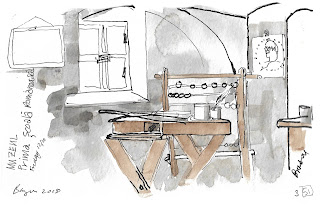MORNING
 |
| Bright dawn |
Wonderful night’s sleep with the promise of less time on the bus today. We will see.
Wednesday morning finds me in better, akin to cheerful, spirits. The breakfast room is large and lovely in glass aquamarine blue however fellow coach buddies (!) sit scarily close which is worrying given this room is so very huge.
 |
| Alba |
 |
| Baroque Alba |
It was a day of sun for sure and up to 23deg. C in the afternoon. The bus time was less than Tuesday. Medieval cities were the theme. Morning it was Alba Julia (White Castle)
and the afternoon was Sibiu.
In the evening we ate in the Jules Bistro and restaurant. White and stylish beyond credulity. Our first red wine of the trip. Local, full bodied and of mature fruit. It was hard to decide whether to sip it or dab in behind one’s ears. Food equally satisfying.
I’d found a post office in Sibiu. This was a longed for experience and I was not disappointed. There was a long queue, of folk tut-tut-ing and only one serving area open. The place was all drab marble, old wood and crumbling posters. Most excellent! I managed, sort of, to jump the queue for seeing one of the counter staff move to where I was standing I beckoned her over and asked for ‘timbres’ Romanian for stamps as we discovered the day before. (Where I had asked for stamps in a children’s clothing shop mistaking it for a Post Office.).
Anyway, yesterday, in a real post office Maria served me with ten stamps for the USA and UK. I was also given some Air Priority stickers as well; my charm and anxious body language did not fail me.
Both cities were reached by the same AutoRoute one of the few in Romania. There is funding for more from the EEC/EU however the current government have not figured out away to skim the funding for their own aggrandisement and for the health and wealth of those road and infrastructure companies who are lucky enough to be awarded the contracts, according to our local guide.
 |
| Sibiu Cathedral Interior |
So, two medieval cities today. Both polished to perfection by EEC/EU funding. Cobbled streets, young people, parked cars, every church either being refurbished (and sadly closed) or freshly painted and open for business.
Sibiu, with its communist apartment blocks and factories well away for the city’s centre, was another cobbled and polished confection. A remarkable number of pharmacies and phone shops all designed to blend in with the overall medieval charm of the place.






































